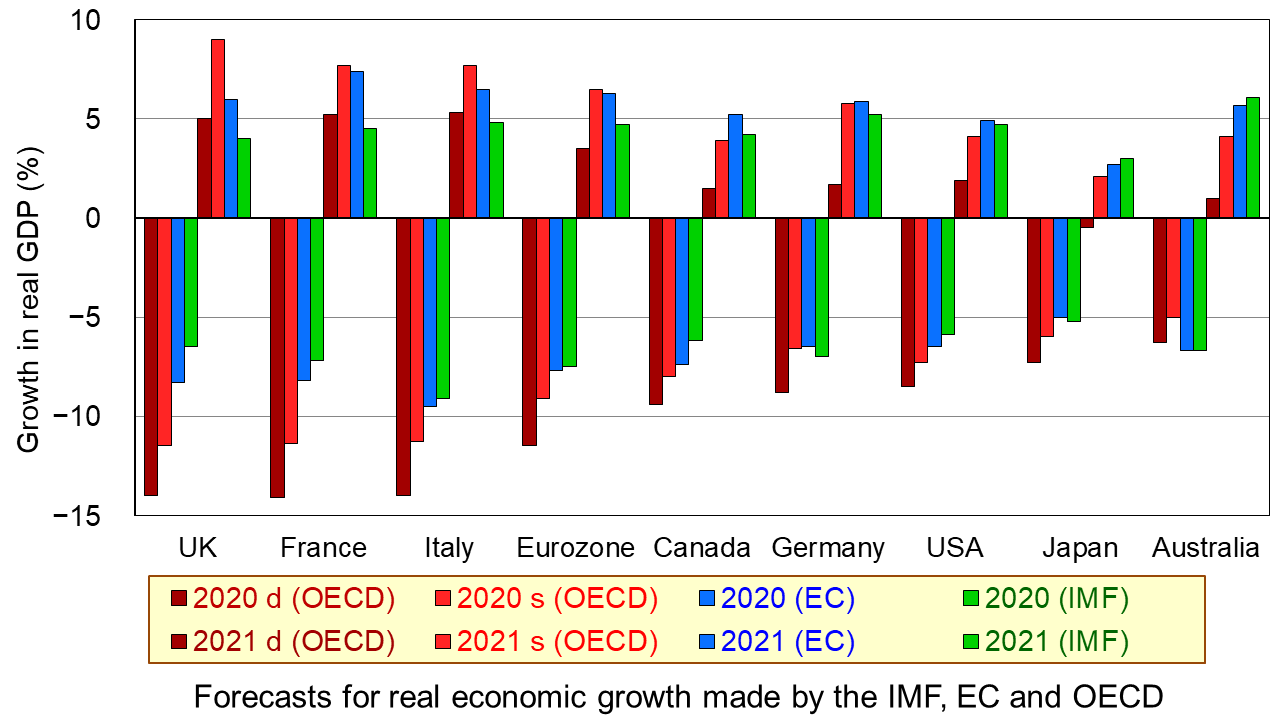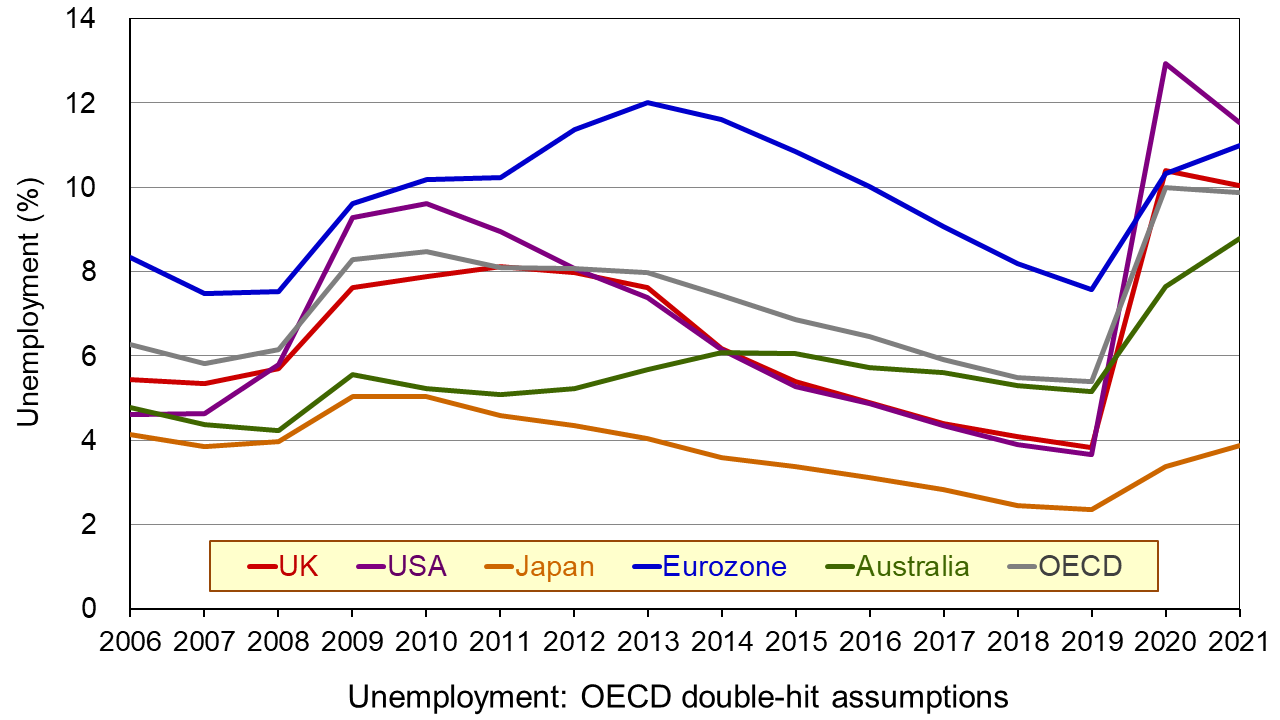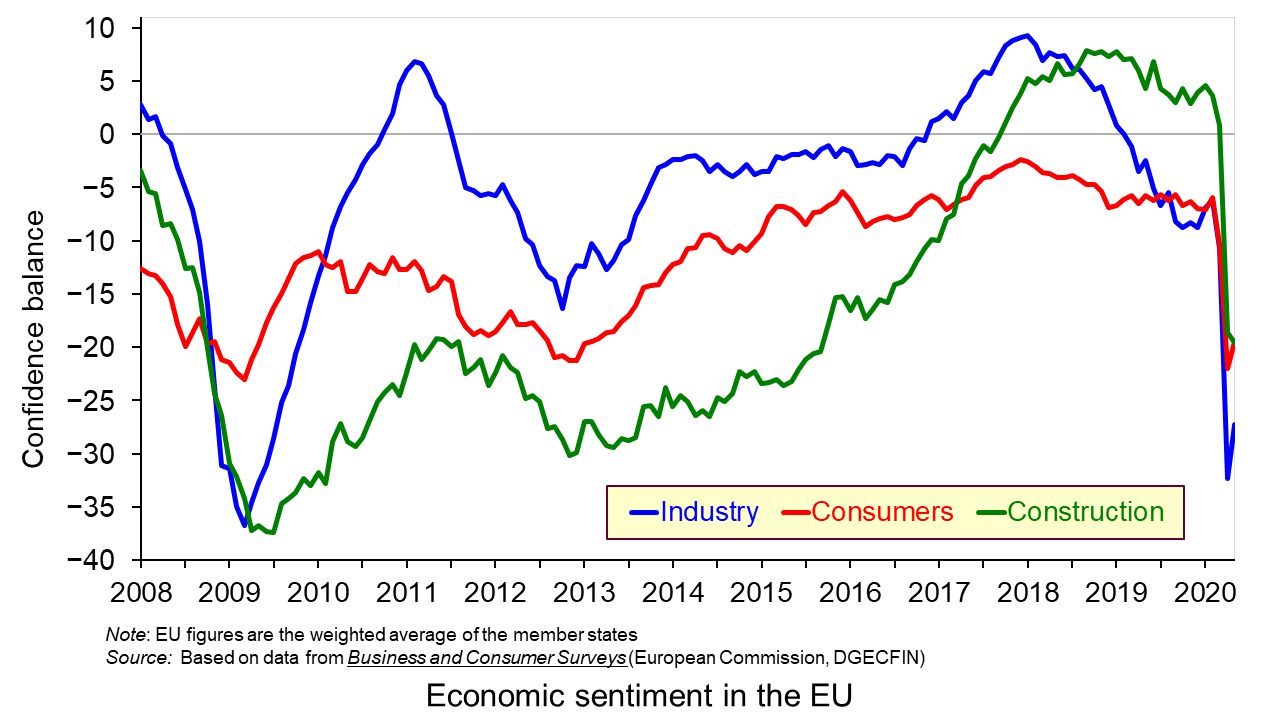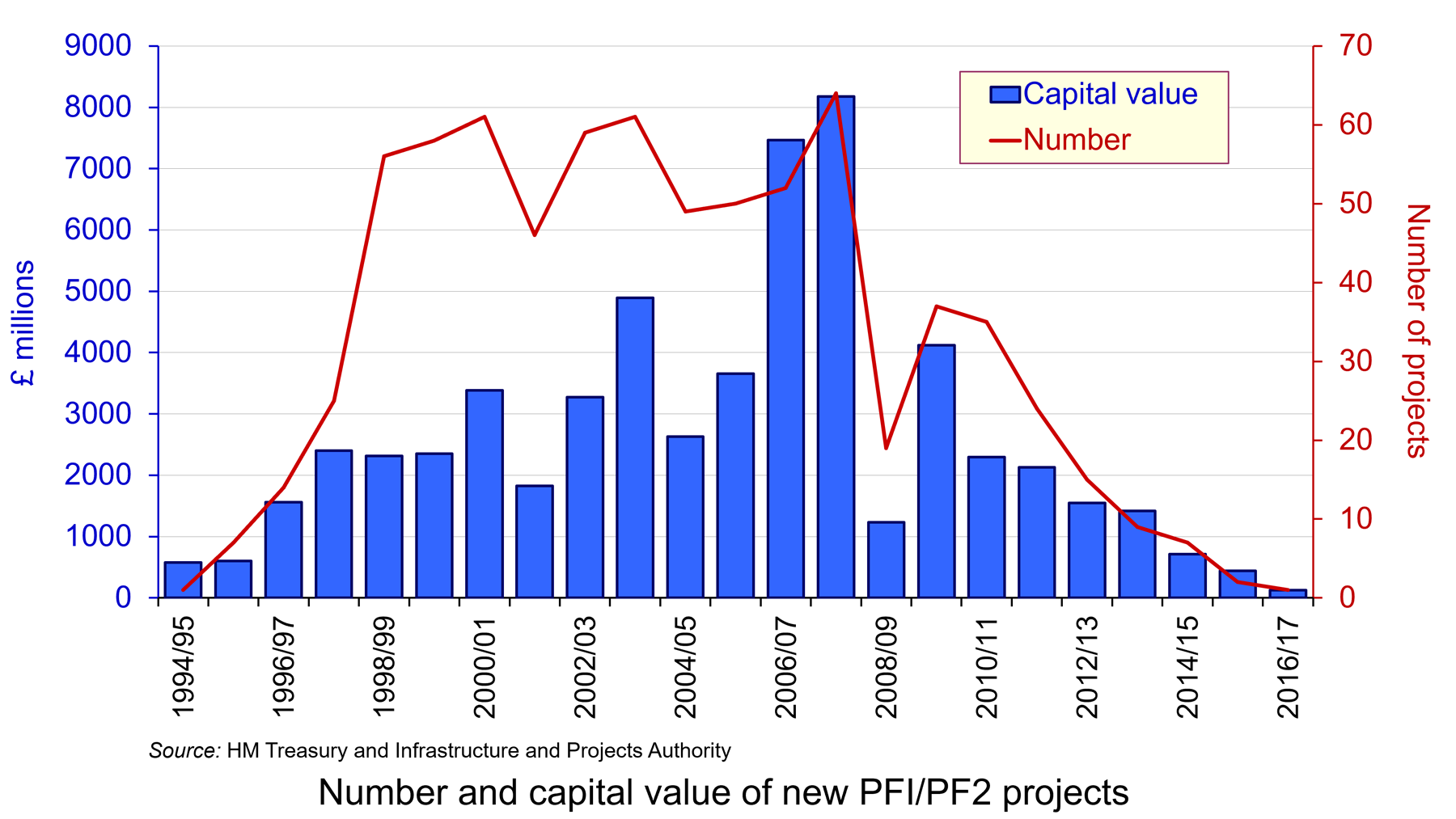 Three international agencies, the IMF, the European Commission and the OECD, all publish six-monthly forecasts for a range of countries. As each agency’s forecasts have been published this year, so the forecasts for economic growth and other macroeconomic indicators, such as unemployment, have got more dire.
Three international agencies, the IMF, the European Commission and the OECD, all publish six-monthly forecasts for a range of countries. As each agency’s forecasts have been published this year, so the forecasts for economic growth and other macroeconomic indicators, such as unemployment, have got more dire.
The IMF was the first to report. Its World Economic Outlook, published on 14 April, forecast that in the UK real GDP would fall by 6.5% in 2020 and rise by 4% in 2021 (not enough to restore GDP to 2019 levels); in the USA it would fall by 5.9% this year and rise by 4.7% next year; in the eurozone it would fall by 7.5% this year and rise by 4.7% next.
The European Commission was next to report. Its AMECO database was published on 6 May. This forecast that UK real GDP would fall by 8.3% this year and rise by 6% next; in the USA it would fall by 6.5% this year and rise by 4.9% next; in the eurozone it would fall by 7.7% this year and rise by 6.3% next.
The latest to report was the OECD on 10 June. The OECD Economic Outlook was the most gloomy. In fact, it produced two sets of forecasts.
The first, more optimistic one (but still more gloomy than the forecasts of the other two agencies) was based on the assumption that lockdowns would continue to be lifted and that there would be no second outbreak later in the year. This ‘single-hit scenario’ forecast that UK real GDP would fall by 11.5% this year and rise by 9% next (a similar picture to France and Italy); in the USA it would fall by 7.3% this year and rise by 4.1% next; in the eurozone it would fall by 9.1% this year and rise by 6.5% next.
The second set of OECD forecasts was based on the assumption that there would be a second wave of the virus and that lockdowns would have to be reinstated. Under this ‘double-hit scenario’, the UK’s GDP is forecast to fall by 14.0% this year and rise by 5.0 per cent next; in the USA it would fall by 8.5% this year and rise by 1.9% next; in the eurozone it would fall by 11.5% this year and rise by 3.5% next.

The first chart shows the four sets of forecasts (including two from the OECD) for a range of countries. The first four bars for each country are the forecasts for 2020; the other four bars for each country are for 2021. (Click here for a PowerPoint of the chart.)

The second chart shows unemployment rates from 2006. The figures for 2020 and 2021 are OECD forecasts based on the double-hit assumption. You can clearly see the dramatic rise in unemployment in all the countries in 2020. In some cases it is forecast that there will be a further rise in 2021. (Click here for a PowerPoint of the chart.)
As the OECD states:
In both scenarios, the recovery, after an initial, rapid resumption of activity, will take a long time to bring output back to pre-pandemic levels, and the crisis will leave long-lasting scars – a fall in living standards, high unemployment and weak investment. Job losses in the most affected sectors, such as tourism, hospitality and entertainment, will particularly hit low-skilled, young, and informal workers.
But why have the forecasts got gloomier? There are both demand- and supply-side reasons.
Aggregate demand has fallen more dramatically than originally anticipated. Lockdowns have lasted longer in many countries than governments had initially thought, with partial lockdowns, which replace them, taking a long time to lift. With less opportunity for people to go out and spend, consumption has fallen and saving has risen. Businesses that have shut, some permanently, have laid off workers or they have been furloughed on reduced incomes. This too has reduced spending. Even when travel restrictions are lifted, many people are reluctant to take holidays at home and abroad and to use public transport for fear of catching the virus. This reluctance has been higher than originally anticipated. Again, spending is lower than before. Even when restaurants, bars and other public venues are reopened, most operate at less than full capacity to allow for social distancing. Uncertainty about the future has discouraged firms from investing, adding to the fall in demand.

On the supply side, there has been considerable damage to capacity, with firms closing and both new and replacement investment being put on hold. Confidence in many sectors has plummeted as shown in the third chart which looks at business and consumer confidence in the EU. (Click here for a PowerPoint of the above chart.) Lack of confidence directly affects investment with both supply- and demand-side consequences.
Achieving a sustained recovery will require deft political and economic judgements by policymakers. What is more, people are increasingly calling for a different type of economy – one where growth is sustainable with less pollution and degradation of the environment and one where growth is more inclusive, where the benefits are shared more equally. As Angel Gurría, OECD Secretary-General, states in his speech launching the latest OECD Economic Outlook:
The aim should not be to go back to normal – normal was what got us where we are now.
Articles
OECD publications
Questions
- Why has the UK economy been particularly badly it by the Covid-19 pandemic?
- What will determine the size and timing of the ‘bounce back’?
- Why will the pandemic have “dire and long-lasting consequences for people, firms and governments”?
- Why have many people on low incomes faced harsher consequences than those on higher incomes?
- What are the likely environmental impacts of the pandemic and government measures to mitigate the effects?
 Late last year I wrote a blog post describing how the UK Competition & Markets Authority (CMA) was looking into Amazon’s investment in online food delivery company Deliveroo. Through this investment Amazon would become a minority shareholder in Deliveroo and be able to participate in the management of the company.
Late last year I wrote a blog post describing how the UK Competition & Markets Authority (CMA) was looking into Amazon’s investment in online food delivery company Deliveroo. Through this investment Amazon would become a minority shareholder in Deliveroo and be able to participate in the management of the company.
At this time the CMA had completed its initial investigation and decided that it had concerns about the impact the investment would have on competition. Since Amazon and Deliveroo did not then offer any proposal to address these concerns, the CMA referred the case for a full-blown investigation. They were not expected to make a decision until June. However, earlier this month the CMA announced that they would provisionally clear the investment.
This decision is a result of the impact coronavirus pandemic has had on the UK economy. The lockdown in the UK has seen many of the restaurants Deliveroo previously delivered from temporarily shutting down. In response, Deliveroo has significantly expanded the online grocery store delivery part of its business. Despite this, it appears that overall the pandemic has significantly reduced their revenues. This will clearly have a significant impact on gig economy workers who, more generally, are particularly affected by the current circumstances (see the earlier post on this site).
 As a result of the pandemic, Deliveroo informed the CMA that they would go out of business without the investment from Amazon. This is very much in line with wider evidence of the impact the pandemic is already having on businesses. The CMA accepted that without additional funding Deliveroo would exit the market and that under the current circumstances it would be very difficult for them to secure an alternative source of funding. Furthermore, they regarded Deliveroo exiting the market as the worst outcome for competition, with Stuart McIntosh, Chair of the inquiry group, stating that:
As a result of the pandemic, Deliveroo informed the CMA that they would go out of business without the investment from Amazon. This is very much in line with wider evidence of the impact the pandemic is already having on businesses. The CMA accepted that without additional funding Deliveroo would exit the market and that under the current circumstances it would be very difficult for them to secure an alternative source of funding. Furthermore, they regarded Deliveroo exiting the market as the worst outcome for competition, with Stuart McIntosh, Chair of the inquiry group, stating that:
This could mean that some customers are cut off from online food delivery altogether, with others facing higher prices or a reduction in service quality. Faced with that stark outcome, we feel the best course of action is to provisionally clear Amazon’s investment in Deliveroo.
The unprecedented circumstances created by the coronavirus pandemic provide a clear justification for the approach the CMA has taken. However, in the long-run there may be adverse consequences for competition. For example, the reduction in competition in online grocery store delivery that the CMA originally feared may materialise. In addition, it will be interesting to see whether the effect the pandemic has on Deliveroo’s business makes it more likely that Amazon will look to fully acquire them.
Articles
Questions
- Distinguishing between the short and long run, how do you think the market would change if Deliveroo were to exit?
- Why do you think it would be difficult for Deliveroo to find alternative sources of funding at the current time?
- What trade-offs would the CMA have had to consider when deciding to clear Amazon’s investment?
 The online market for food delivery has grown rapidly grown in recent years. Deliveroo was founded in 2013 and has become one of the most recognised brands in this market. It now has a presence in around 100 towns and cities in the UK. In addition to offering customers restaurant cooked meals delivered straight to their homes, Deliveroo also provides a grocery store delivery service, for example in partnership with the Co-op.
The online market for food delivery has grown rapidly grown in recent years. Deliveroo was founded in 2013 and has become one of the most recognised brands in this market. It now has a presence in around 100 towns and cities in the UK. In addition to offering customers restaurant cooked meals delivered straight to their homes, Deliveroo also provides a grocery store delivery service, for example in partnership with the Co-op.
Despite Deliveroo’s strong brand, the market leader in online restaurant delivery is actually Just Eat. Just Eat’s business model is built on it acting as an intermediary between restaurants and consumers who can use Just Eat’s website or app to order take-aways. This is in contrast to Deliveroo which also provides the delivery service. This means that Just Eat’s service is more viable in smaller towns. Deliveroo’s other main rival is Uber Eats.
Having been founded in the UK, Deliveroo has subsequently expanded its operations to around 10 other countries. However, this global expansion resulted in Deliveroo making losses of almost £200m in 2017. In part as a result of these losses, Deliveroo decided to look for new investment and by May 2019 had raised £450m. Deliveroo intends to use this money to fund its continued international expansion and to improve the service it provides. This includes growing its delivery-only kitchens business, which enables it to be less reliant on links with traditional restaurants.
Amazon was one of the big investors in Deliveroo, although the exact amount it invested is unknown. Interestingly, both Amazon and Uber have previously made approaches to buy Deliveroo outright. For Amazon this latest move may be a first step before looking to fully acquire Deliveroo.
 Despite this not being a full merger or acquisition, it was still investigated by the UK Competition and Markets Authority (CMA). Its remit allows it also to examine situations where an enterprise gains a ‘material influence over the policy of another’. This was the case with Amazon’s investment which, despite only allowing it to become a minority shareholder, enables it to participate in the management of the company.
Despite this not being a full merger or acquisition, it was still investigated by the UK Competition and Markets Authority (CMA). Its remit allows it also to examine situations where an enterprise gains a ‘material influence over the policy of another’. This was the case with Amazon’s investment which, despite only allowing it to become a minority shareholder, enables it to participate in the management of the company.
Last week the CMA announced that it had completed its initial investigation and that it had concerns about the investment. Andrea Gomes de Silva, CMA Executive Director, stated that:
If the deal were to proceed in its current form, there’s a real risk that it could leave customers, restaurants and grocers facing higher prices and lower quality services as these markets develop. This is because the significant competition which could otherwise exist between Amazon and Deliveroo would be reduced.
The CMA has two specific concerns. Firstly, it is worried that competition in online restaurant delivery will be harmed. Amazon had started competing with Deliveroo in this market in 2016 when it launched Amazon Restaurants. However, it shut this down two years later. The CMA uncovered internal documents from Amazon suggesting that it continued to monitor closely this market. Therefore, the CMA believed that Amazon re-entering the market was a distinct possibility and argued that this would be a substantial boost for competition. The CMA’s concern was that its investment in Deliveroo would make this re-entry less likely.
On the other hand, there is a counterargument to the CMA’s which says that Amazon’s entry through investment, even if only at this time resulting in minority ownership of Deliveroo, could itself boost competition. This is an important trade-off the CMA should take into account.

Secondly, the CMA is worried that Amazon’s investment will also harm competition in online grocery store delivery. Here, Amazon and Deliveroo are two of the leading players in the market. The CMA believes that, as the market grows in the future, competition between the two could intensify. However, the investment in Deliveroo would put this in jeopardy.
At the time of writing, Amazon and Deliveroo have five working days to offer proposals to the CMA to address these competition concerns. It will be interesting to see how they respond to the CMA and whether a full-blown investigation follows. If it does, this may eventually lead to the CMA blocking Amazon’s investment.
POSTSCRIPT: Amazon and Deliveroo did not offer a proposal to address the competition concerns and so on 27th December the CMA referred the case for a full-blown investigation.
To be continued.
Articles
Questions
- What are the key features of competition in the online market for food delivery?
- What are the pros and cons of Just Eat’s business model in comparison with Deliveroo’s?
- What are the potential advantages Amazon has over the other players in the online market for food delivery?
 One of the announcements in the recent UK Budget was the ending of the Private Finance Initiative (PFI), including its revised form, PF2. PFI was introduced by the Conservative government in 1992. Subsequently, it was to become central to the Labour government’s ‘Third-way’ approach of using the private sector to deliver public projects and services.
One of the announcements in the recent UK Budget was the ending of the Private Finance Initiative (PFI), including its revised form, PF2. PFI was introduced by the Conservative government in 1992. Subsequently, it was to become central to the Labour government’s ‘Third-way’ approach of using the private sector to deliver public projects and services.
PFI involves a public–private partnership (PPP). The private sector builds and/or runs public projects, such as new schools, hospitals, roads, bridges, student accommodation, and so on. The public sector, in the form of government departments, NHS foundation trusts, local authorities, etc., then pays the private sector company a rent for the infrastructure or pays the company to provide services. The benefit of PFI is that it allows private-sector capital to be used for new projects and thus reduces the need for government to borrow; the disadvantage is that it commits the public-sector body to payments over the long-term to the company involved.

As the chart shows, PFI became an important means of funding public service provision during the 2000s. In the 10-year period up to financial year 2007/08, more than 50 new projects were being signed each year.
As the number of projects grew and with them the long-term financial commitments of the public sector, so criticisms mounted. These included:
- Quality and cost. It was claimed that PFI projects were resulting in poorer quality of provision and that cost control was often poor, resulting in a higher burden for the taxpayer in the long term.
- Credit availability. PFI projects are typically dependent on the private partner using debt finance to acquire the necessary funds. Therefore, credit conditions affect the ability of PFI to fund the delivery of public services. With the credit crunch of 2008/9, many firms operating PFI projects found it difficult to raise finance.
- The financial health of the private partner. What happens if the private company runs into financial difficulties. In 2005, the engineering company Jarvis only just managed to avoid bankruptcy by securing refinancing on all 14 of its PFI deals.
PF2
Recognising these problems, in 2011 the government set up a review of PFI. The result was a revised form of PFI, known as ‘PF2’. PF2 projects involved tighter financial control, with the government acting as a minority co-investor; more robust tendering processes, with bidders required to develop a long-term financing solution, where bank debt does not form the majority of the financing of the project; the removal of cleaning, catering and other ‘soft services’.
Despite the government’s intention that PPPs remain an important plank of its funding of public services, the number of new PFI/PF2 projects has nonetheless declined sharply during the 2010s as the chart shows. Of the 715 PPP projects as of 31 March 2017, 631 had been signed before May 2010. Indeed, in 2016/17 only 1 new project was signed.
The collapse of Carillion
 Concerns over PPPs remained despite the reforms under PF2. These were brought dramatically into focus with the collapse of Carillion plc (see the blog, Outsourcing, PFI and the demise of Carillion). Carillion was a British company focused on construction and facilities management (i.e. support services for organisations). It was a significant private-sector partner in PPP projects. By 2014 it had won 60 PPP projects in the UK and Canada, including hospitals, schools, university buildings, prisons, roads and railways.
Concerns over PPPs remained despite the reforms under PF2. These were brought dramatically into focus with the collapse of Carillion plc (see the blog, Outsourcing, PFI and the demise of Carillion). Carillion was a British company focused on construction and facilities management (i.e. support services for organisations). It was a significant private-sector partner in PPP projects. By 2014 it had won 60 PPP projects in the UK and Canada, including hospitals, schools, university buildings, prisons, roads and railways.
However, Carillion had increasing burdens of debt, caused, in part, by various major acquisitions, including McAlpine in 2008. Events came to a head when, on 15 January 2018, an application was made to the High Court for a compulsory liquidation of the company.
A subsequent report for the House of Commons Public Administration and Constitutional Affairs Committee in light of the collapse of Carillion found that procurement procedures were fundamentally flawed. It found that contracts were awarded based on cost rather than quality. This meant that some contracts were not sustainable. Between 2016 and the collapse of Carillion the government had been forced to renegotiate more than £120m of contracts so that public services could continue.
The ending of PPPs?
On 18 January 2018, the National Audit Office published an assessment of PFI and PF2. The report stated that there were 716 PFI and PF2 projects at the time, either under construction or in operation, with a total capital value of £59.4 billion. In recent years, however, ‘the government’s use of the PFI and PF2 models had slowed significantly, reducing from, on average, 55 deals each year in the five years to 2007/8 to only one in 2016/17.’
At its conference in September 2018, the Labour shadow chancellor, John McDonnell, said that, if elected, a Labour government would not award any new PFI/PF2 contracts. He claimed that PFI/PF2 contracts were set to cost the taxpayer £200bn over the coming decade. Labour policy would be to review all existing PFI/PF2 contracts and bring the bulk of them fully back into the public sector.
Then in the Budget of 29 October 2018, the Chancellor announced that no further PFI/PF2 projects would be awarded, although existing ones would continue.
I have never signed off a PFI contract as chancellor, and I can confirm today that I never will. I can announce that the government will abolish the use of PFI and PF2 for future projects.
We will honour existing contracts. But the days of the public sector being a pushover, must end. We will establish a centre of excellence to actively manage these contracts in the taxpayers’ interest, starting in the health sector.
But does this mean that there will be no more public-private partnerships, of which PFI is just one example? The answer is no. As the Chancellor stated:
And in financing public infrastructure, I remain committed to the use of public-private partnership where it delivers value for the taxpayer and genuinely transfers risk to the private sector.
But just what form future PPPs will take is unclear. Clearly, the government will want to get value for money, but that depends on the mechanisms used to ensure efficient and high-quality projects. What is more, there is still the danger that the companies involved could end up with unsustainable levels of debt if economic circumstances change and it will still involve a burden on the taxpayer for the future.
Articles
Questions
- Find out how PF2 differs from PFI and assess the extent to which it overcame the problems identified with PFI.
- The government is not bringing back existing PFI contracts into the public sector, whereas the Labour Party would do so – at least with some of them. Assess the arguments for and against bringing PFI contracts ‘in-house’.
- Find out why Carillion collapsed. To what extent was this due to its taking on PFI contracts?
- What were the main findings of the National Audit Office’s assessment of PFI and PF2?
- The government still supports the use of public-private partnerships (PPPs). What form could these take other than as PFI/PF2 contracts? Would the problems associated with PFI/PF2 also apply to PPPs in general?
 The Winter Olympics are full on as athletes from all over the world compete against each other, hoping to set new world records, win medals and be known as Olympians. Pyeongchang, the South Korean county that hosts the 2018 Winter games, enjoys a large influx of tourists – estimated at 80,000 people a day. This is certainly an unusually large number of tourists for a region that has a regular winter-time population of no more than 45,000 people.
The Winter Olympics are full on as athletes from all over the world compete against each other, hoping to set new world records, win medals and be known as Olympians. Pyeongchang, the South Korean county that hosts the 2018 Winter games, enjoys a large influx of tourists – estimated at 80,000 people a day. This is certainly an unusually large number of tourists for a region that has a regular winter-time population of no more than 45,000 people.
Having such a high number of visitors to the Winter Olympics, and even more to the larger Summer Olympics, is not an unusual occurrence, however, and it is often mentioned as one of the benefits of being a host to the Olympic Games.
Baade and Matheson (see link below) distinguish between three key benefits of hosting the Olympic Games: “the short-run benefits of tourist spending during the Games; the long-run benefits or the ‘Olympic legacy’, which might include improvements in infrastructure and increased trade, foreign investment, or tourism after the Games; and intangible benefits such as the ‘feel-good effect’ or civic pride”.
On these grounds, a number of studies have been authored, attempting to analyse some or all of these benefits, distinguishing between short-term and long-term effects. Müller (see link below), uses data from the 2014 Oympic Games in Sochi, Russia, to assess the net economic outcome for the host region. He concludes that any short-term economic benefits caused by the investment influx (before and during the games) could not offset the long-term costs, leading to an estimated net loss of $1.2 billion per year.
Zimbalist (2015) and Szymanski (2011) report similar results when analysing data from the London Games (2012) and past major sporting events (Games and FIFA World Cup). Kasimati (2003) points out the significant economic benefits that host regions tend to enjoy for years after hosting the games, but argues that the overall effect depends on a number of factors (including pre-existing infrastructure and location).
The jury is, therefore, still out on what is the overall economic effect of being host to this ancient institution. But I must now dash as women’s hockey is soon to start. “Let everyone shine”.
Articles
For the sake of the games, South Korea needs to show hosting an Olympics can be economically viable CNBC, Yen Nee Lee (15/2/18)
South Korea’s Olympic bet is unlikely to pay off, economics professor says CNBC, Andrew Wong and Andrew Zimbalist (12/2/18)
Going for the Gold: The Economics of the Olympics Journal of Economic Perspectives, Robert A. Baade and Victor A. Matheson (Spring 2016)
After Sochi 2014: Costs and Impacts of Russia’s Olympic Games Eurasian Geography and Economics, Martin Müller (9/4/15)
Circus Maximus: The Economic Gamble Behind Hosting the Olympics and the World Cup The Brookings Institution, Andrew Zimbalist (14/1/15)
About Winning: The Political Economy of Awarding the World Cup and the Olympic Games SAIS Review of International Affairs, Stefan Szymanski (Winter/Spring 2011)
Economic aspects and the Summer Olympics: a review of related research International Journal of Tourism Research, Evangelia Kasimati (4/11/03)
“Let Everyone Shine”: the song for the PyeongChang 2018 Torch Relay unveiled with 200 days to go Olympic Committee (24/7/17)
Video
 The Olympic Winter Games PyeongChang 2018 Torch Relay Official Song PyeongChang 2018
The Olympic Winter Games PyeongChang 2018 Torch Relay Official Song PyeongChang 2018
Questions
- Using supply and demand diagrams, explain whether you would expect hotel room prices to change during the hosting of a major sports event, such as the Winter Olympics.
- List three economic (or economics-related) arguments in favour of and against the hosting of the Olympic games. Relate your answer to the empirical evidence presented in the literature.
- Why is it so difficult to estimate with accuracy the net economic effect of the Olympic Games?
 Three international agencies, the IMF, the European Commission and the OECD, all publish six-monthly forecasts for a range of countries. As each agency’s forecasts have been published this year, so the forecasts for economic growth and other macroeconomic indicators, such as unemployment, have got more dire.
Three international agencies, the IMF, the European Commission and the OECD, all publish six-monthly forecasts for a range of countries. As each agency’s forecasts have been published this year, so the forecasts for economic growth and other macroeconomic indicators, such as unemployment, have got more dire. 


 OECD Economic Outlook, June 2020: the World Economy on a Tightrope
OECD Economic Outlook, June 2020: the World Economy on a Tightrope Global economy faces a tightrope walk to recovery
Global economy faces a tightrope walk to recovery Late last year I wrote a blog
Late last year I wrote a blog  As a result of the pandemic, Deliveroo informed the CMA that they would go out of business without the investment from Amazon. This is very much in line with wider
As a result of the pandemic, Deliveroo informed the CMA that they would go out of business without the investment from Amazon. This is very much in line with wider  The online market for food delivery has grown rapidly grown in recent years. Deliveroo was founded in 2013 and has become one of the most recognised brands in this market. It now has a presence in around 100 towns and cities in the UK. In addition to offering customers restaurant cooked meals delivered straight to their homes, Deliveroo also provides a grocery store delivery service, for example in partnership with the Co-op.
The online market for food delivery has grown rapidly grown in recent years. Deliveroo was founded in 2013 and has become one of the most recognised brands in this market. It now has a presence in around 100 towns and cities in the UK. In addition to offering customers restaurant cooked meals delivered straight to their homes, Deliveroo also provides a grocery store delivery service, for example in partnership with the Co-op.
 One of the announcements in the recent UK Budget was the ending of the
One of the announcements in the recent UK Budget was the ending of the 
 Concerns over PPPs remained despite the reforms under PF2. These were brought dramatically into focus with the collapse of Carillion plc (see the blog,
Concerns over PPPs remained despite the reforms under PF2. These were brought dramatically into focus with the collapse of Carillion plc (see the blog, 